Marker Text: Founded 1897 by the Berwind-White Coal Mining Co. Distinctive among bituminous coal towns, this community had a large independent center surrounded by 13 "patch towns." Among notable structures built by Berwind-White were the Wilmore Building here (1914) and Arcadia Theatre across the street (1919). Thousands of immigrants came across here to work the mines; largest in output was Eureka Mine #40, 2 miles NW. Company mining ceased, 1962
Location: At the intersection of Graham Avenue (Pennsylvania Route 160) and 15th Street near street address, 501 15th St., Windber. Erected by the Pennsylvania Historical and Museum Commission in 1999.
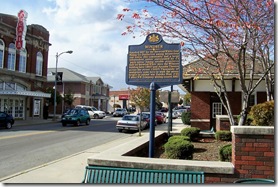 Today's marker I discovered while specifically looking for markers about Alan Freed and Johnny Weissmuller, both whom lived here during their childhood. On the same street there were two other markers. I did not know anything about “Windber” and the other marker the “Windber Strike of 1922-23” before my visit.
Today's marker I discovered while specifically looking for markers about Alan Freed and Johnny Weissmuller, both whom lived here during their childhood. On the same street there were two other markers. I did not know anything about “Windber” and the other marker the “Windber Strike of 1922-23” before my visit.
Windber is a borough in Somerset County, Pennsylvania, eight miles south of Johnstown. It was at one time a place of industrial activities which included coal mining, lumber, and the manufacture of fire brick. In 1897, the community was founded as a company town by Charles and Edward Julius Berwind owners of the Berwind Corporation based in Philadelphia, PA.
A company town is a town or city in which much or all real estate, buildings; residential and commercial, utilities, hospitals, small businesses, such as, grocery stores and gas stations, and other necessities or luxuries of life within its borders are owned by a single company. One of the first company towns in the United States was in Pullman, Illinois developed in the 1880's just outside the Chicago city limits. The town, entirely company-owned, provided housing, markets, a library, churches and entertainment for the 6,000 company employees and an equal number of dependents.
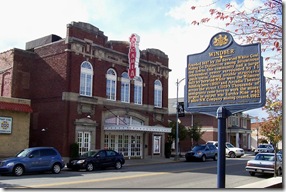 Another famous company town was McDonald, Ohio, which was created by the Carnegie Steel Company to house and serve the needs of its employees in the Youngstown, Ohio area. This overarching control of the lives of miners and their families served to intimidate workers who might otherwise have been tempted to protest low wages or dangerous working conditions.
Another famous company town was McDonald, Ohio, which was created by the Carnegie Steel Company to house and serve the needs of its employees in the Youngstown, Ohio area. This overarching control of the lives of miners and their families served to intimidate workers who might otherwise have been tempted to protest low wages or dangerous working conditions.
According to available records, there were more than 2,500 company towns, housing three percent of the U.S. population at the peak of their existence in the early 1900's. Many company towns were centered around a single manufacturing center, such as, steel, lumber, manufacturing, coal, etc.
In front of the Municipal Building is a statue of a Coal Miner dedicated to all the coal miners who worked in the community. Plaque on the statue is pictured below. (Click any photo to enlarge)
Among the dozens of company towns that developed with bituminous mining in southwestern Pennsylvania, the town of Windber stands alone. Even when compared to other "model" company towns, Windber's unique plan of one large independent town center surrounded by thirteen dependent mining settlements, or "patch towns," set it apart. Coal mining put its best face forward through the tree-lined streets of downtown Windber, but it was the small mining villages that defined life for most of its miners.
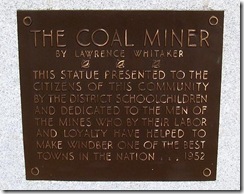 Windber was the creation of the Berwind-White Coal Mining Company, one of six coal companies owned by industrialist Edward J. Berwind. Due to the scope and scale of his operations, Berwind Corporation was considered the largest company in bituminous coal mining. At the time of Berwind's death in 1936, he was reported to be the largest individual owner of coal properties in the country. Company towns were promoted as being beneficial to the workers and their families and in many ways this was true particularly for new immigrants to the U.S. needing employment and a community to live and belong. Despite these initial benefits, their chief purpose was about the company maintaining control and power over their workforce. If they had trouble with an employee, they could fire him and evict his family, making sure to deduct that month's rent and company store purchases from the wages due him. With very troublesome employees, particularly those involved in union organizing activities, the company could blacklist them making it difficult to get other employment in any nearby community.
Windber was the creation of the Berwind-White Coal Mining Company, one of six coal companies owned by industrialist Edward J. Berwind. Due to the scope and scale of his operations, Berwind Corporation was considered the largest company in bituminous coal mining. At the time of Berwind's death in 1936, he was reported to be the largest individual owner of coal properties in the country. Company towns were promoted as being beneficial to the workers and their families and in many ways this was true particularly for new immigrants to the U.S. needing employment and a community to live and belong. Despite these initial benefits, their chief purpose was about the company maintaining control and power over their workforce. If they had trouble with an employee, they could fire him and evict his family, making sure to deduct that month's rent and company store purchases from the wages due him. With very troublesome employees, particularly those involved in union organizing activities, the company could blacklist them making it difficult to get other employment in any nearby community.
Like other company towns, Windber was conceived as a place to house workers whom the company employed in its neighboring mines. By September 1897, the company erected its first set of company houses and conferred the town's name, an anagram derived from the company's owner and founder. But company officials also envisioned Windber as a corporate headquarters and command center for their expanding western Pennsylvania mining operations. As a result, the town had amenities unheard of in standard company towns: wide, tree-lined streets; a central park with bandstand; relatively well-appointed and maintained detached workers houses; and a downtown commercial district bustling with independent retailers and specialty shops. Company officials billed it as the "metropolis of Somerset County," and encouraged outside investors.
By 1910 company officials had erected thirteen “patch towns” on the outskirts of Windber to house workers closer to new mines. In contrast to Windber proper, “patch towns" were stripped to their bare essentials. Each was just far enough removed from Windber and one another to warrant their own cluster of housing but very little else. A Eureka Company Store, a no-frills version of the downtown store, was located in the center of town. Most “patch towns” did not even have their own name, beyond the number of the mine with which each was associated, for example residents living at Mine #40 simply referred to it as 40. Due to the high rate of European immigrants in the U.S. during this period and aggressive recruiting efforts of immigrant labor, Windber by 1911 had about seventy-five percent foreign-born residents.

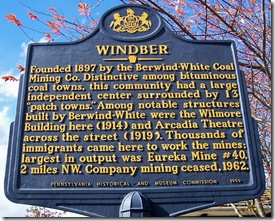
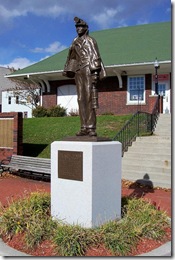
No comments:
Post a Comment